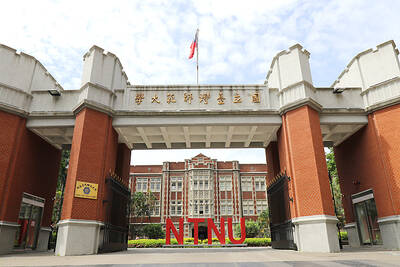A magnitude 6.1 earthquake shook southeastern Taiwan early yesterday, the Central Weather Bureau said. No major damage was reported as of press time.
The epicenter of the earthquake was at sea, about 33.6km east of Taitung County Hall at a depth of 18.4km, the bureau said, adding that the earthquake at 4:06am produced intensity readings of five in eastern Taiwan on the nation’s zero-to-seven seismic intensity scale.
The quake was felt in Kaohsiung with an intensity of between three and four, prompting alarmed netizens to post messages online expressing alarm and warning people to be cautious.
As yesterday was Valentine’s Day, some netizens dubbed the quake the “Valentine’s Day limited edition.”
Meanwhile, the strength of the quake felt in Pingtung County gave rise to concern over the county’s Ma-anshan Nuclear Power Plant, as in 2006 a magnitude 7.1 earthquake triggered the emergency shutdown of its No. 2 reactor.
In response to these concerns, state-run Taiwan Power Co (Taipower) officials said the intensity of yesterday’s earthquake was not enough to bring about a shutdown.
Seven seismic instruments were installed at the plant in the wake of the Fukushima Dai-ichi nuclear disaster in Japan and an emergency shutdown would be automatically triggered if the instruments register peak ground acceleration (PGA) exceeding 0.2g, the officials said, adding that yesterday’s quake only registered a PGA of 0.0136g and did not have any affect on the plant’s operations.
However, the seismic instruments recorded a PGAof 0.175g during the 2006 earthquake, making it the largest motion registered since recording commenced at the site, Taipower officials said.
Plant staff inspected all the in-plant facilities following standard operating procedures soon after the seismic instruments had registered ground motion, the officials said, adding that no damage or anomaly was found.
The generating systems did not falter and both reactors in the plant have been operating at full capacity, according to the officials.
The plant was originally designed to operate under 0.4g PGA — equivalent to a magnitude 8 earthquake — however, a NT$100 million (US$3.1 million) reinforcement project completed last year makes the plant able to operate under 0.72g PGA, Taipower officials said, adding that the reinforcement included installation of connecting bolts, replacement and enlargement of infrastructural steel plates, and augmentation of pile-supported foundations for storage tanks.
In related news, the Taiwan Railways Administration (TRA) said a total of 36 train services were delayed as of 9:30am due to earthquake, adding that the delays affected nearly 3,000 passengers.
Additional reporting by Hung Ting-hung and CNA

Taiwan yesterday condemned the recent increase in Chinese coast guard-escorted fishing vessels operating illegally in waters around the Pratas Islands (Dongsha Islands, 東沙群島) in the South China Sea. Unusually large groupings of Chinese fishing vessels began to appear around the islands on Feb. 15, when at least six motherships and 29 smaller boats were sighted, the Coast Guard Administration (CGA) said in a news release. While CGA vessels were dispatched to expel the Chinese boats, Chinese coast guard ships trespassed into Taiwan’s restricted waters and unsuccessfully attempted to interfere, the CGA said. Due to the provocation, the CGA initiated an operation to increase

CHANGING LANDSCAPE: Many of the part-time programs for educators were no longer needed, as many teachers obtain a graduate degree before joining the workforce, experts said Taiwanese universities this year canceled 86 programs, Ministry of Education data showed, with educators attributing the closures to the nation’s low birthrate as well as shifting trends. Fifty-three of the shuttered programs were part-time postgraduate degree programs, about 62 percent of the total, the most in the past five years, the data showed. National Taiwan Normal University (NTNU) discontinued the most part-time master’s programs, at 16: chemistry, life science, earth science, physics, fine arts, music, special education, health promotion and health education, educational psychology and counseling, education, design, Chinese as a second language, library and information sciences, mechatronics engineering, history, physical education

The Chinese military has boosted its capability to fight at a high tempo using the element of surprise and new technology, the Ministry of National Defense said in the Quadrennial Defense Review (QDR) published on Monday last week. The ministry highlighted Chinese People’s Liberation Army (PLA) developments showing significant changes in Beijing’s strategy for war on Taiwan. The PLA has made significant headway in building capabilities for all-weather, multi-domain intelligence, surveillance, operational control and a joint air-sea blockade against Taiwan’s lines of communication, it said. The PLA has also improved its capabilities in direct amphibious assault operations aimed at seizing strategically important beaches,

‘MALIGN PURPOSE’: Governments around the world conduct espionage operations, but China’s is different, as its ultimate goal is annexation, a think tank head said Taiwan is facing a growing existential threat from its own people spying for China, experts said, as the government seeks to toughen measures to stop Beijing’s infiltration efforts and deter Taiwanese turncoats. While Beijing and Taipei have been spying on each other for years, experts said that espionage posed a bigger threat to Taiwan due to the risk of a Chinese attack. Taiwan’s intelligence agency said China used “diverse channels and tactics” to infiltrate the nation’s military, government agencies and pro-China organizations. The main targets were retired and active members of the military, persuaded by money, blackmail or pro-China ideology to steal